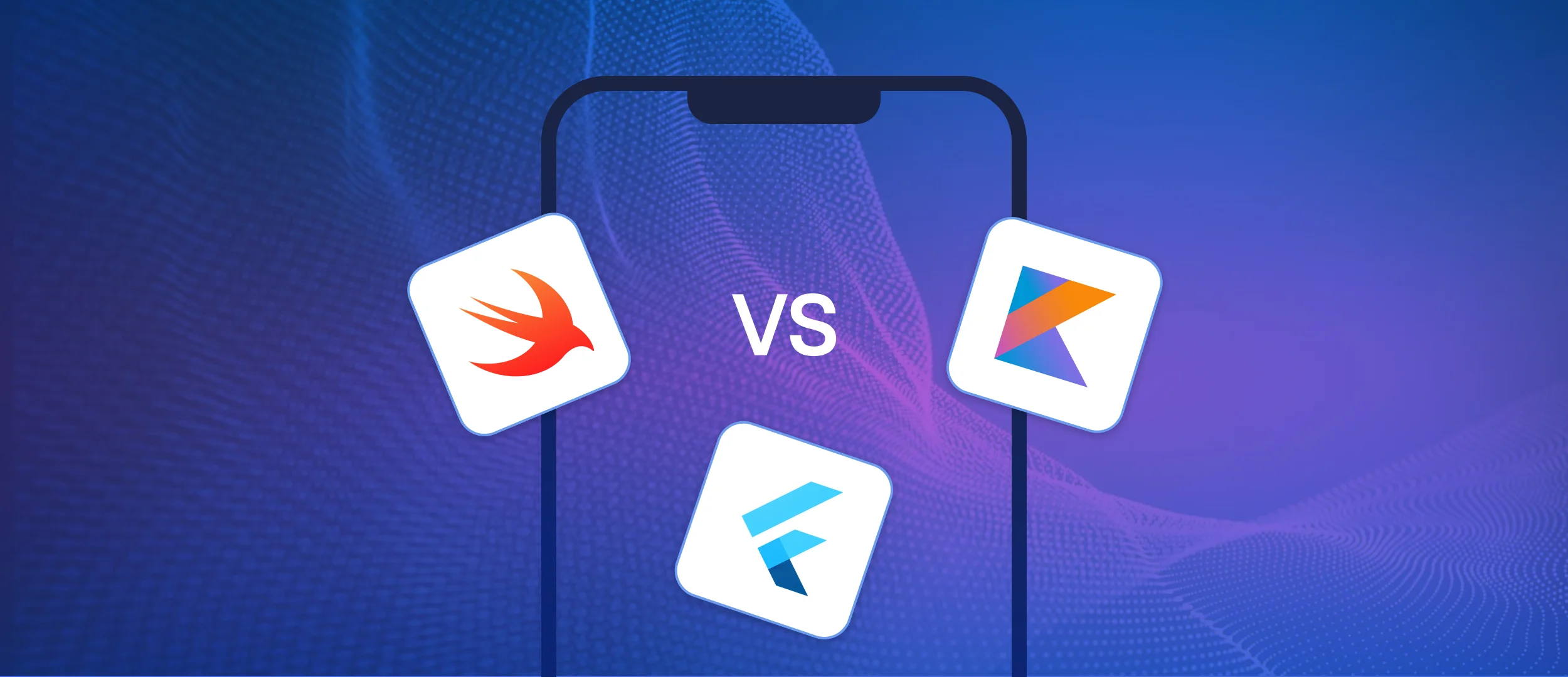
First of all, I propose to find out what native vs cross-platform app development is and what the differences are. The native application is developed in the language proposed by the developers of a mobile platform. For example, there is a choice between Kotlin and Java for Android solutions development, and for iOS app creation, one can select Swift or Objective-C. Through these languages usage the developer gets direct access to the platform’s functionality — the SDK.
Cross-platform mobile applications are developed from a single codebase, with the primary aim being to target various operating systems within a single project. These applications are crafted using cross-platform frameworks, which leverage platform-specific SDKs like Android SDK and iOS SDK through a unified API. This approach facilitates easy access to different platform SDKs and libraries.
These frameworks are typically created by private companies. Some popular examples of cross-platform frameworks include:
- App development with React Native which employs JavaScript as the programming language.
- Flutter by Google, utilizing Dart as the programming language.
- .NET MAUI by Microsoft (formerly Xamarin), which employs C# and XAML as the programming language.
Cross-platform mobile apps are typically compiled to utilize native user interface elements, providing a native look and feel to the app. As mentioned earlier, these apps offer an abstraction layer to the underlying platform SDKs and grant access to sensors such as GPS, battery level, camera, and microphone.
Pros of Native Mobile Applications
Developing native mobile applications offers several advantages:
- Superior Performance: Native apps are designed and optimized for specific platforms, utilizing the core programming language and APIs of that platform. This results in exceptional speed, efficiency, and responsiveness to user interactions.
- Robust Security: Native apps can enhance user data security by utilizing platform-specific, built-in security features.
- High-Quality User Experience (UX): Native apps deliver a seamless user input and output experience. They inherit the interface and design elements of the device's operating system, ensuring a consistent and natural flow.
- Full Feature Access: Native mobile apps can leverage all device features and functionalities, providing a rich, integrated user experience. They can access services like push notifications, which are pivotal for user engagement.
- Minimal Bugs: Native app developers receive prompt access to updated SDKs with enhancements and new features.
Cons of Native Mobile Applications
Despite their benefits, native mobile applications also have drawbacks:
- Cost: Deploying native apps can be expensive, as it necessitates separate teams of developers for different platforms. For instance, creating a native Android app requires developers proficient in Java or Kotlin, and for native iOS, Swift/Objective-C developers are needed.
- Longer Development Time: Managing distinct teams working on similar apps for various platforms can be time-consuming. Maintenance and updates also demand substantial effort.
- Lack of Code Reusability: To target multiple mobile operating systems, separate codebases need to be maintained for each platform, leading to code duplication.
Pros of Cross-Platform Mobile Applications
Cross-platform mobile app development offers several advantages:
- Cost Efficiency: It requires only a single team of developers proficient in the chosen framework, reducing development costs. This approach enables the app to reach a broader audience quickly, aiding in market testing and traction.
- Code Reusability: Cross-platform frameworks promote the use of a single codebase, ensuring consistency in the business logic applied throughout the app.
- Expedited Development: By reusing code and enhancing productivity, cross-platform development allows faster time-to-market. These frameworks have streamlined the app testing process during development.
- Simplified Maintenance: Updating a cross-platform app is more straightforward due to the single codebase. All builds for various platforms share the same code, ensuring consistency.
Cons of Cross-Platform Mobile Applications
While cross-platform mobile development addresses some of the limitations of native app development, it has its own set of drawbacks:
- Larger Digital Footprint: Cross-platform apps tend to be larger in size, requiring careful consideration of mobile optimization options.
- Complex Integrations: Cross-platform frameworks may not seamlessly integrate all platform-specific features. Certain hardware-specific integrations, such as GPU usage, may necessitate skills in native app development.
- Reduced Performance: Cross-platform frameworks often include a custom runtime to facilitate app execution, adding an additional layer of computation. This can result in decreased performance.
- Delayed Platform Features: New SDK releases frequently introduce fresh features and updates. With cross-platform frameworks, access to these newer features typically requires waiting for a separate update.
Native vs Cross-Platform App Development
It’s essential to realize that though business logic will be the same in the app, the implementation of the interface and applied features will differ. Android and iOS have, for instance, quite different conceptual and architectural approaches to the work with the background processes and push notifications processing. It results in the necessity to create an additional code, which should adjust the logic of the app execution.
When global сhanges to the platform user interface take place, these changes won’t automatically reflect in hybrid apps. The developers will then need time to implement certain changes in design as well as in the behavior of the UI components. The recent update of iOS 13 can be a perfect example in this case, it brought great changes in the user interface. If the native components had been used there would not have been any problems.
Special attention should be drawn to the possible mistakes in the modules work on specific platforms. During the work with video recording and its further rendering, for instance, one may face the situation when there is a mirror imaging on one platform and normal display on the other.
Problematic implementation of the functionality is also possible. While the problems are unlikely to set in with map or points on map integration, the payment system integration or popular in some parts of the world social media networks support may cause difficulties. To integrate such functionality, bridges should be created for each platform. In other words, you should realize such functionality support natively for each platform and create middleware for the technology chosen. It’s essential to keep in mind that in course of the time, the changes will take place in such functional interdependencies, and they will require changes in the newly written modules.
Aspects to Pay Attention in Native vs Cross-Platform App Development
Cost. It’s one of the main aspects important for the client. Though the development team in such projects is smaller, the expertise of each member should be more extensive. A specialist should not only know the target technology but native programming languages as well. It’s necessary to implement changes in the existing modules and possibly write new custom ones. The hourly rate of such experts is usually much higher than the native developers’.
The terms of development. Taking into consideration the constant development of target platforms and setting certain additional restrictions by each platform, it becomes more and more difficult to make estimations as to the terms of a certain functionality implementation. Besides, the risk which will be included for the client during the project evaluation may exceed the cost of the functionality development several times.
The learning curve for the new developers of the extensive apps will be quite high and much more time will be needed to add new features or alter the existing ones, not speaking about the risks of the increasing number of errors subject to the difficulty of the project itself.
To draw a line, I’d suggest to always carefully evaluate the difficulty of such a project, and estimate the cost and scope of it in detail. To my mind, the disadvantages prevail to a greater extent over the possible advantages of cross-platform app usage. It’s important to warn the clients against the situations when the half-ready product would be re-written from scratch on native technologies because of some blockers or inability to realize certain functionality in cross-platform apps. Native applications are much easier to support in long-term projects, especially when developed by a professional mobile application development agency.
Conclusion
To develop a successful, stable, and well-received mobile application, it's crucial to decide which operating system or systems you intend your app to be compatible with. While both native and cross-platform development methods can be utilized for Android and iOS, it's essential to carefully weigh the tools, techniques, advantages, and disadvantages associated with each approach during the app development process.
Whether your target users use Android or iOS, it's imperative to prioritize security, performance, and scalability when creating your application. There's no one-size-fits-all solution for mobile app development. Native vs cross-platform app development each has its own merits and limitations, and the choice should be driven by the unique requirements of each mobile app project. If you are interested in creating a top-tier product, contact us, and our dedicated team will gladly help you.



